
The world is shrinking, and not just on a map. How we do business is becoming increasingly “borderless,” with companies of all sizes forging partnerships and conducting international transactions. But this trend comes with a unique challenge: ensuring legal compliance, particularly when it comes to the use of electronic signatures.
E-signatures are rapidly gaining traction as a convenient and secure alternative to traditional handwritten ones. However, with this global adoption comes the need to understand the legal landscape surrounding e-signatures in different countries.
Navigating this complex terrain is crucial for businesses operating internationally to ensure the validity and enforceability of their e-signed documents. This article will be your guide, helping you click through the intricacies and navigate the legalities of e-signatures across the globe.
Navigating E-Signatures in North America: A Two-Nation Adventure
Our first stop on this global e-signature journey takes us across North America’s vast and diverse landscape. Here, we’ll explore the legal frameworks of two key players: the United States and Canada.
United States: The Land of the ESIGN Act and UETA
The U.S. has established a strong foundation for e-signatures with the Electronic Signatures in Global and National Commerce Act (ESIGN Act). Under certain conditions, this federal statute grants e-signatures the same legal standing and enforceability as conventional handwritten signatures.
Most states have adopted the Uniform Electronic Transactions Act (UETA), which further harmonizes e-signature laws across state lines. PS Industry Research estimates The e-signature industry to be worth $1.53 billion.

Navigating the legal environment around e-signatures in the United States isn’t a one-size-fits-all affair. Here are a few essential things to remember:
- Specific legal requirements: Certain documents, such as wills and trusts, may still require wet signatures in some states.
- Consent of the signer: All parties involved must explicitly consent to use e-signatures.
- Security and record-keeping: Businesses must ensure the integrity and security of their e-signature processes and maintain proper records of electronic transactions.
Canada: Where PIPEDA Paves the Way
North of the border, Canada takes a similar approach to e-signatures. The federal Personal Information Protection and Electronic Documents Act (PIPEDA) recognizes e-signatures as legally valid, provided they meet specific criteria. Additionally, each province may have its e-signature regulations that complement PIPEDA.
Understanding the legal framework for e-signatures in Canada is just as crucial as in the U.S. Here’s a brief overview:
- Similar to the U.S., certain documents may still require wet signatures.
- Consent and security remain paramount.
- Understanding provincial regulations alongside PIPEDA is vital for complete legal compliance.
Crossing the E-Signature Bridge to Europe: Navigating the EU and the UK
Next, we embark on a European adventure, exploring the legal landscape of e-signatures in the European Union and the United Kingdom.
European Union: United by eIDAS
The EU boasts the eIDAS Regulation as its cornerstone for e-signatures in the land of diverse cultures and shared regulations. Since this regulation unifies the member states’ legal systems, e-signatures from one state are recognized by all.
It simplifies cross-border transactions and promotes legal certainty for businesses operating within the EU. Forecasts indicate a digital signature industry growth of 35.1% from 2023 to 2030.

The eIDAS Regulation offers three types of e-signatures, each with varying levels of security:
- Simple Electronic Signature (SES): This low-risk signature can be a scanned image of a handwritten signature or a typed name.
- Advanced Electronic Signature (AdES): This signature is linked to the signatory and is created using a secure creation device.
- Qualified Electronic Signature (QES): This highest signature level is based on a qualified certificate from a trusted third party and offers the strongest legal presumption of validity.
United Kingdom: Charting a Post-Brexit Course
Following its departure from the EU, the UK has established its e-signatures framework. Despite the UK government’s desire to closely follow the eIDAS regulation, there are some important differences:
- The UK’s framework needs to differentiate between QES and AdES. Businesses need to be more specific about the type of e-signature used for certain transactions.
- UK Qualified Certificates (UK QCs) issued by UK Trust Service Providers may not be automatically recognized in the EU.
Understanding these nuances is crucial for businesses operating in the UK to ensure legal compliance when using e-signatures. Consulting with legal counsel familiar with UK e-signature regulations is highly recommended.
The best electronic signature software providers can also guide navigating these complexities and ensuring compliance with UK regulations. To stay out of legal hot water, businesses must abide by the UK and EU’s e-signature legislation revisions.
Unveiling E-Signatures in Asia-Pacific: Exploring Australia and Singapore
Our e-signature expedition now takes us to the vibrant and diverse region of Asia-Pacific. Here, we’ll delve into the legal frameworks of two key countries: Australia and Singapore.
Australia: Where the Electronic Transactions Act Reigns Supreme

Down under, the Electronic Transactions Act (ETA) sets the stage for e-signatures. This law creates a strong foundation for the enforceability and legal validity of e-signatures as long as specified requirements are met.
Here’s a glimpse into the key requirements for using e-signatures in Australia:
- Consent from all parties involved is mandatory.
- The technology used to create the e-signature must be reliable and capable of identifying the signatory.
- Businesses must demonstrate the integrity of the e-signature process and maintain proper records of electronic transactions.
Understanding these requirements is crucial for businesses operating in Australia to ensure their e-signatures are legally binding.
Singapore: A Tech Hub with Clear E-Signature Guidelines
Across the water, Singapore, a renowned tech hub, also embraces e-signatures. Like Australia, the Electronic Transactions Act (ETA) forms the foundation for their legal framework. However, Singapore goes a step further by providing specific regulations for different types of e-signatures based on their level of security.
Here are some key considerations for businesses operating in Singapore:
- It is crucial to understand the different types of e-signatures and their suitability for various transactions.
- Compliance with specific regulations associated with each e-signature type is essential.
- Consulting with legal counsel familiar with Singaporean e-signature laws is highly recommended.
Signatures South of the Border: A Latin American Adventure
As we continue our global exploration of e-signatures, let’s set our sights on the vibrant and diverse region of Latin America. Here, we’ll delve into the legal frameworks of two key countries: Brazil and Mexico.
Brazil: Where Law and Innovation Collide
In the heart of South America, Brazil takes a unique approach to e-signatures. Electronic signatures are authorized under the Brazilian Civil Code. However, they must be accompanied by a digital certificate issued by a certifying agency approved by the Brazilian government. This requirement adds an extra layer of security but can also involve additional steps and costs.
Brazil also has Medida Provisória 2.200-2 (MP 2.200-2), a temporary measure that sometimes simplifies e-signatures. This measure allows for using simpler e-signatures, such as those based on digital tokens or biometrics, without needing a government-issued certificate.
Signatures on email attachments or online forms can now be done more easily and quickly in Brazil. It is primarily due to the interim provision enacted by Medida Provisória 2.200-2.
It’s important to note that MP 2.200-2 is temporary, and its future status is subject to legislative approval. Here’s a quick overview of the legal framework for electronic signatures in Brazil:
- Traditional e-signatures require a government-issued certificate (under the Civil Code).
- MP 2.200-2 allows simpler e-signatures (temporary measures) in specific scenarios.
- Consulting with legal counsel familiar with Brazilian e-signature laws is highly recommended.
Mexico: Embracing E-Signatures with a Legal Framework
Mexico’s Federal Law on Electronic Signatures (Ley Federal de Firma Electrónica) governs e-signatures north of the equator. This law recognizes various e-signatures, each with varying security and legal weight.

Here are some key considerations for businesses operating in Mexico:
- The type of e-signature used should be appropriate for the specific transaction and its legal requirements.
- Compliance with the Federal Law of Electronic Signatures is essential.
- Consulting with legal counsel familiar with Mexican e-signature laws is highly recommended.
Venturing into the E-Signature Landscape of Africa: Exploring South Africa and Nigeria
Our final destination on our global e-signature journey is Africa, a vibrant and diverse continent. Here, we’ll delve into the legal frameworks of two key countries: South Africa and Nigeria.
South Africa: A Nation Forging a Digital Future
The Electronic Communications and Transactions Act (ECT Act) has helped South Africa advance technological innovation. This legal framework covers electronic signatures on documents. This act grants legal validity and enforceability to e-signatures, provided they meet specific criteria:
- The e-signature must be capable of identifying the signatory and be linked to the data it is attached to.
- The process used to create the e-signature must be reliable and secure.
- There must be a mechanism to ensure the integrity of the e-signature and the data it is associated with.
South African businesses must understand and implement these guidelines to ensure the legitimacy of their digitized signatures.
Nigeria: Embracing E-Signatures with the Electronic Transactions Act
Nigeria, another economic powerhouse in the continent, has adopted the Electronic Transactions Act (ETA) to govern the use of e-signatures. This act establishes a legal framework similar to South Africa’s, recognizing the validity of e-signatures under specific conditions:
- The e-signature creation process must be reliable and secure.
- The signatory must consent to the use of an e-signature.
- A mechanism must ensure the integrity of the e-signature and the attached data.
Here are some key considerations for businesses operating in Nigeria:
- Choosing the appropriate e-signature solution that meets the legal requirements outlined in the ETA.
- Seeking legal counsel familiar with Nigerian e-signature laws is highly recommended for navigating the complexities and ensuring compliance.
Conclusion
Our examination of the regulations regulating electronic signatures worldwide uncovers a diverse environment. From long-standing frameworks in the United States and the European Union to novel ideas in Brazil and South Africa. This variety emphasizes the need to recognize regional differences for global enterprises.
Compliance with local e-signature laws isn’t just legal; it’s essential for ensuring the enforceability of your agreements. By navigating these legalities, you pave the way for smooth, secure, and legally sound interactions across borders.
Remember, the e-signature landscape is ever-evolving. Stay informed, adapt your approach, and keep exploring to ensure your business thrives in this interconnected world.



